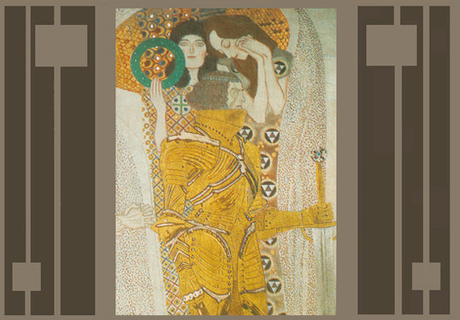by Paul J. Pelkonen

Detail from The Knight in Shining Armor: Pity and Ambition
by Gustav Klimt as appears on the cover of the Beethoven Symphony No. 3 recording reviewed herein.
Art and rendering © 1987 DG/UMG
Hi all. I'm back after a relaxing, grounding and enervating week in the woods of Northern Maryland. Today we are talking about Beethoven, and specifically a new to me recording of the Eroica Symphony which I am listening to as I type. This is an old (but new to me) recording of Beethoven's 'Eroica' Symphony, made in 1987 by the Vienna Philharmonic. No, that's not terribly "old" in a business with historic recordings that go back to the turn of the 20th century, but it is definitely the product of another time. The conductor is the late and brilliant Claudio Abbado, who would later record these same symphonies in his job as music director of the Berlin Philharmonic is the conductor here and there is much of interest in this performance.
To start with the string sound, captured with a perfect clarity by the DG engineers, bring out the full bodied sound of the Viennese players, whose five string sections were at the time the envy of the world. The tone has a faint hint of yearning and need in each note, reaching for something higher as they enter and exit the dance floor of the first movement. Mr. Abbado opts for a very sober and measured approach to this music, perhaps a little too fussy for its time but in retrospect an interpretation well worth considering.
The Eroica was a key piece in my own musical education, serving as the centerpiece to the class 'The Age of Beethoven' that I took in my sophomore year at Fordham under the good offices of Dr. James Kurtz. This was the second Kurtz class I took at the school, and the one where I and my less enthusiastic classmates learned such skills as how to break down the components of a sonata form, how to read a piano score (of the Beethoven sonatas, I still have both volumes of mine) and how to understand the architecture of the Eroica, a work that, like the church of Hagia Sophia in Istanbul, was built on a scale never seen before in a symphony.
This recording was made in the late 80s, at the same time the halcyon and twilight years of the recording business before the revolutions of Napster, iTunes and Pandora swept and flooded the music industry as we knew it. Back then, music stores had vast supermarket like shelves of LPs and CDs. impossibly stocked granaries with everything one needed or wanted available for purchase. Since then, the prices are better for us music lovers but the resources are considerably fewer. This recording for example, cost me a whopping two bucks on Amazon, plus an (ahem) shopping cost.
The slow and stately approach pays off dividends in the Funeral March, taken at a pace that emphasizes the gravitas of this music and its content. Mr. Abbado's conducting also emphasizes all the new sounds and tearing dissonances that fill these pages: the brass sounds like the Last Judgement and the strings weep with the inconsolable pain that so inspired the work of Gustav Mahler, himself another Abbado specialty. The live recording captures the detail and attention to small things that made him a great conductor of opera and symphony, and the coda passage provides a sort of comfort after the torment that has gone before.
On to the dance movement. The Viennese do footwork like nobody else, moving nimbly through the scherzo passages with first and second violins in counterpoint with the specialized oboes that are a trademark of their sound. There is one point in the second reprise where the orchestra descends by sounding like they are falling down the stairs. The horn solos, played on those narrow bore horns with the unique valve mechanism that dates from another century, are suitably crude and energized.
The vague bustle and hiss of audience noise appears in the start of the Prometheus variations that make up the fourth movement. Not only does the rustle of sheet music and shift of an audience member in the Goldensaal add to the sense of "live" recording, the playing is also magnificent. One could see Mr. Abbado dancing lightly on the podium as the variations roll forth, with the upward glissandi of the strings an indication of the conductor's control. Even when the miusic gets busy and crowded he still maintains control over the traffic. In the end though it is the ornate, heaven-storming counterpart that starts from small musical ideas and ends with a blazing, roaring hearth-fire of joy.

